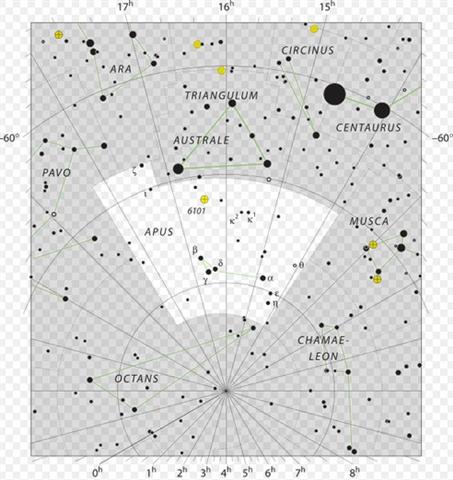The Apus constellation has 10 stars with Greek letters, none of them very bright and none of them with proper names: 
In the current investigation only the last pair of stars in Apus are of possible interest:
We can see that the beautiful bird of Paradise with no feet cannot be touched by the flames from the Altar - the constellation is ending just before the Altar is beginning. Instead, the brighter stars above Ara belong in the Southern Triangle, another fairly modern conception:
"Triangulum Australe is a small constellation in the far southern celestial hemisphere. Its name is Latin for 'the southern triangle', which distinguishes it from Triangulum in the northern sky and is derived from the almost equilateral pattern of its three brightest stars. It was first depicted on a celestial globe as Triangulus Antarcticus by Petrus Plancius in 1589, and later with more accuracy and its current name by Johann Bayer in his 1603 Uranometria. The French explorer and astronomer Nicolas Louis de Lacaille charted and gave the brighter stars their Bayer designations in 1756." (Wikipedia) The form of the triangle obviously could have described the flames of fire on the Altar and it is strange that these stars do not belong in Ara. "Its varied classical names show disagreement as to its form, yet great familiarity with its stars, on the part of early observers, with whom it was of importance as portending changes in the winds and weather; Aratos devoting twenty-eight lines - a large proportionate space - of the Phainomena to this character of Ara." (Allen) I guess 28 lines was a Sign of Aratos. 28 * 13 = 364. Anyhow, I ought to list also the stars of Triangulum Australe. Also they are 10 in number:
Only α has a proper name, viz. Atria. (The name of α Trianguli is Metallah.) Atria, the last star in the constellation, was close to the Full Moon in May 30 (150):
| |||||||||||||||||||||||||||||||||||||||||||||||||||||||||||||||||||||||||||||||||||||||||||||||||||||||||||||||||||||||||||||||||||||||||||||||||||||||||||||||||||||||||||||||||||||||||||||||||||||||||||||||||||||||||||||||||||||||||||||||||||||||||||||||||||||||||||||||||||||||||||||||||||||








